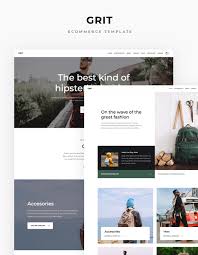The Importance of Website Design
In today’s digital age, having a well-designed website is crucial for businesses and individuals alike. Your website is often the first point of contact between you and your audience, making it essential to create a positive and lasting impression.
Professionalism and Credibility
A well-designed website conveys professionalism and credibility. It shows that you care about your online presence and are dedicated to providing a quality experience for your visitors. A visually appealing design can help build trust with your audience and encourage them to engage with your content.
User Experience
User experience is key to the success of any website. A well-designed site is easy to navigate, with clear menus, intuitive layouts, and fast loading times. Visitors are more likely to stay on a site that is user-friendly, leading to higher engagement and conversion rates.
Brand Identity
Your website design plays a significant role in shaping your brand identity. It should reflect your brand’s values, aesthetics, and messaging. Consistent branding across all elements of your site helps reinforce brand recognition and loyalty among your audience.
Mobile Responsiveness
In an increasingly mobile world, having a responsive website design is essential. Your site should adapt seamlessly to different screen sizes and devices to provide a consistent experience for all users. Mobile responsiveness also improves SEO rankings, as search engines prioritize mobile-friendly sites.
Call to Action
An effective website design incorporates clear calls to action (CTAs) that guide visitors towards desired actions, such as making a purchase or contacting you. Well-placed CTAs can improve conversion rates and lead to measurable results for your business.
Conclusion
Website design is more than just aesthetics – it is a powerful tool for establishing credibility, enhancing user experience, strengthening brand identity, improving mobile accessibility, and driving conversions. Investing in professional web design can have a significant impact on the success of your online presence.
5 Key Benefits of Effective Website Design: Boosting Credibility, User Experience, and Engagement
- Enhances credibility and professionalism
- Improves user experience and navigation
- Strengthens brand identity and recognition
- Increases mobile responsiveness and accessibility
- Drives higher engagement and conversion rates
Three Common Website Design Pitfalls That Can Drive Away Visitors
- Poor website design can result in a negative user experience, leading to high bounce rates and low engagement.
- Complex or cluttered designs may confuse visitors and make it difficult for them to find the information they are looking for.
- Outdated website designs can give the impression that a business is not current or innovative, potentially turning away potential customers.
Enhances credibility and professionalism
A well-designed website enhances credibility and professionalism by presenting a polished and trustworthy online presence. Visitors are more likely to perceive a business or individual as reputable and reliable when they encounter a website that is visually appealing, easy to navigate, and thoughtfully designed. A professional website design conveys attention to detail and a commitment to quality, instilling confidence in visitors and encouraging them to engage with the content or services offered.
Improves user experience and navigation
A well-designed website significantly enhances user experience and navigation by providing intuitive layouts, clear menus, and easy-to-find information. When users can effortlessly navigate a website and quickly locate the content they are looking for, they are more likely to stay engaged and explore further. A user-friendly design not only improves satisfaction but also encourages visitors to spend more time on the site, ultimately leading to higher levels of interaction and conversions.
Strengthens brand identity and recognition
A well-crafted website design plays a crucial role in strengthening brand identity and recognition. By incorporating consistent branding elements such as colors, fonts, and imagery across the site, businesses can create a cohesive and memorable online presence that resonates with their target audience. This visual consistency helps build brand recognition and loyalty, making it easier for customers to identify and connect with the brand across various online platforms.
Increases mobile responsiveness and accessibility
One significant advantage of well-designed websites is their ability to increase mobile responsiveness and accessibility. In today’s mobile-driven world, having a website that is optimized for various devices ensures a seamless user experience across smartphones, tablets, and other mobile gadgets. This enhanced mobile responsiveness not only caters to the growing number of mobile users but also improves search engine rankings, as search engines prioritize mobile-friendly websites. By prioritizing mobile accessibility in website design, businesses can reach a wider audience and provide a user-friendly experience that encourages engagement and conversions.
Drives higher engagement and conversion rates
A well-designed website has the ability to drive higher engagement and conversion rates by creating a user-friendly experience that encourages visitors to interact with the content and take desired actions. Through intuitive navigation, compelling visuals, and strategically placed calls to action, a thoughtfully designed website can captivate users, keep them on the site longer, and ultimately lead them towards making a purchase, filling out a form, or subscribing to a service. By focusing on user engagement and optimizing the conversion funnel, businesses can leverage the power of effective website design to increase conversions and achieve their goals.
Poor website design can result in a negative user experience, leading to high bounce rates and low engagement.
When a website is poorly designed, it can create a frustrating user experience that drives visitors away. Confusing navigation, slow loading times, cluttered layouts, and unresponsive design elements can all contribute to a negative impression. As a result, users are more likely to leave the site quickly without engaging with its content or taking desired actions. High bounce rates and low engagement metrics are common consequences of poor website design, highlighting the importance of investing in user-friendly and visually appealing designs to retain visitors and encourage interaction.
Complex or cluttered designs may confuse visitors and make it difficult for them to find the information they are looking for.
Complex or cluttered website designs can be a significant drawback as they have the potential to overwhelm visitors and hinder their ability to navigate the site effectively. When a website is filled with too much information, intricate layouts, or excessive visual elements, it can confuse users and make it challenging for them to locate the specific information they seek. This can lead to frustration, increased bounce rates, and a negative overall user experience. Simplifying the design and focusing on clear organization and navigation can help mitigate this issue and ensure that visitors can easily find the information they need.
Outdated website designs can give the impression that a business is not current or innovative, potentially turning away potential customers.
Outdated website designs can have a detrimental impact on a business by conveying the message that the company is not current or innovative. In today’s fast-paced digital landscape, where trends and technologies are constantly evolving, a stagnant website design can give the impression that the business is not keeping up with the times. This lack of freshness and relevance may deter potential customers who are seeking modern and forward-thinking brands to engage with. It is essential for businesses to regularly update their website designs to reflect their commitment to staying current and meeting the expectations of their audience.




